Text

How Can an E-Commerce SEO Audit Boost Your Business? Europe Website Designer
A comprehensive e-commerce SEO audit conducted by Europe Website Designer can significantly enhance your business by improving your online visibility, driving organic traffic, and increasing sales. Our expert team thoroughly analyzes your website's structure, content, keywords, backlinks, and overall SEO performance to identify areas of improvement. By optimizing your site's on-page elements, such as meta tags, headers, and URLs, we ensure that search engines can easily crawl and index your pages, leading to higher rankings in search results.
#Hire Expert Digital Marketing Company India#looking for SEO Service Company India#looking for PPC Service Company India#looking for Digital Marketing Company India#Digital Marketing Service Company#Hire Expert Digital Marketing Company
1 note
·
View note
Text

How Partnering With A Marketing Agency Can Help Your Business | Connect Infosoft
Partnering with a marketing agency like Connect Infosoft can significantly benefit your business by providing expert guidance and comprehensive solutions to enhance your marketing efforts. With our extensive knowledge and experience in the field, we understand the ever-evolving digital landscape and can help you navigate it effectively.
Our team of skilled professionals will work closely with you to develop a tailored marketing strategy that aligns with your business goals and target audience. Whether you need assistance with search engine optimization, social media management, content creation, or paid advertising, we have the expertise to deliver measurable results.
#How partnering with a Marketing Agency can help your business#Hire Expert Digital Marketing/PPC/SEO Service Company India#looking for SEO Service Company India#looking for PPC Service Company India#looking for Digital Marketing Company India#Digital Marketing Service Company#Hire Expert Digital Marketing
1 note
·
View note
Text
Partnering with a marketing agency like Connect Infosoft can significantly benefit your business by providing expert guidance and comprehensive solutions to enhance your marketing efforts. With our extensive knowledge and experience in the field, we understand the ever-evolving digital landscape and can help you navigate it effectively.
Our team of skilled professionals will work closely with you to develop a tailored marketing strategy that aligns with your business goals and target audience. Whether you need assistance with search engine optimization, social media management, content creation, or paid advertising, we have the expertise to deliver measurable results.
#How partnering with a Marketing Agency can help your business#Hire Expert Digital Marketing/PPC/SEO Service Company India#looking for SEO Service Company India#looking for PPC Service Company India#looking for Digital Marketing Company India#Digital Marketing Service Company#Hire Expert Digital Marketing
1 note
·
View note
Text
How Partnering With A Marketing Agency Can Help Your Business | Connect Infosoft
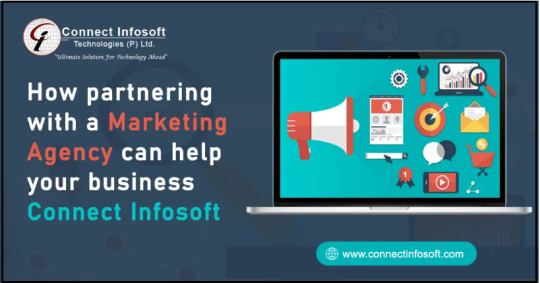
Partnering with a digital marketing service or company is a great way to get your business up and running in the digital world. A marketing agency can provide you with a team of experts who will be able to assist you in making sure that your digital marketing campaigns are on point. From developing a comprehensive digital strategy to executing campaigns across different channels such as email marketing, social media marketing, content marketing, and more, a digital marketing agency can help you reach your desired goals.
By working with an experienced digital marketing agency, you can rest assured that your campaigns are being developed and managed effectively. An experienced agency will have a deep understanding of how different digital marketing channels work, what kind of content and campaigns should be used to reach your target audience, and how to measure the success of your campaigns. This means that you’ll be able to get the most out of your marketing budget and maximize your return on investment (ROI).
With the help of a digital marketing agency, you’ll also be able to save time and effort. By allowing a team of professionals to handle your campaigns, you’ll have more time to focus on other important aspects of your business. You won’t have to worry about researching new techniques, developing strategies or implementing campaigns.
Overall, partnering with a digital marketing service or company can help you get the best results for your business. With the right guidance, you can ensure that your digital marketing campaigns are successful and effective.
Conclusion:
Partnering with a marketing agency like Connect Infosoft can significantly benefit your business by providing expert guidance and comprehensive solutions to enhance your marketing efforts. With our extensive knowledge and experience in the field, we understand the ever-evolving digital landscape and can help you navigate it effectively.
Our team of skilled professionals will work closely with you to develop a tailored marketing strategy that aligns with your business goals and target audience. Whether you need assistance with search engine optimization, social media management, content creation, or paid advertising, we have the expertise to deliver measurable results.
#How partnering with a Marketing Agency can help your business#Hire Expert Digital Marketing/PPC/SEO Service Company India#looking for SEO Service Company India#looking for PPC Service Company India#looking for Digital Marketing Company India#Digital Marketing Service Company#Hire Expert Digital Marketing
1 note
·
View note
Text
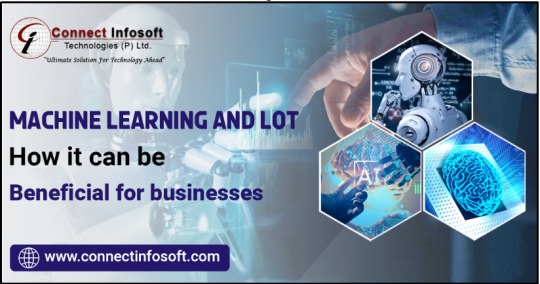
Machine Learning And IoT: How It Can Be Beneficial For Businesses?
The combination of machine learning and IoT presents significant benefits for businesses. By leveraging machine learning algorithms on IoT devices, businesses can extract valuable insights from the vast amount of data generated by these interconnected devices. This allows for real-time analysis, predictive modeling, and intelligent decision-making. Machine learning can help optimize processes, detect anomalies, and improve efficiency within IoT systems.
#Machine Learning And IoT How It Can Be Beneficial For Businesses#Machine Learning Development Service#Best Machine Learning development company#AI#Artificial Intelligence#Machine Learning#Manufacturing#ML#open-source#Training Data
1 note
·
View note
Text
The combination of machine learning and IoT presents significant benefits for businesses. By leveraging machine learning algorithms on IoT devices, businesses can extract valuable insights from the vast amount of data generated by these interconnected devices. This allows for real-time analysis, predictive modeling, and intelligent decision-making. Machine learning can help optimize processes, detect anomalies, and improve efficiency within IoT systems.
#Machine Learning Development Service#Best Machine Learning development company#AI#Artificial Intelligence#Machine Learning#Manufacturing#ML#open-source#Training Data
1 note
·
View note
Text
Machine Learning And IoT: How It Can Be Beneficial For Businesses?
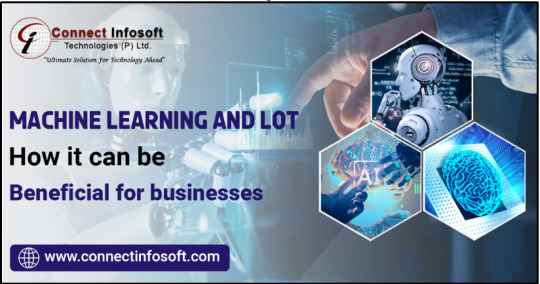
The machine learning field is growing rapidly, along with IoT. Small cameras and other IoT components are now easily available on mobile devices, computers, traffic control systems, parking systems, and home appliances. Millions of IoT devices are manufactured worldwide that collect a variety of data kept in the machines through the internet, allowing machines to understand more precisely that data and make them more useful in a simple way.
Machine learning and the Internet of Things (IoT) are two powerful technologies that, when combined, can bring significant benefits to businesses.
Here are some ways in which the integration of machine learning and IoT can be advantageous:
Predictive Maintenance: IoT devices can collect real-time data from various sensors embedded in equipment or machinery. Machine learning algorithms can analyze this data to detect patterns and anomalies, allowing businesses to predict when maintenance is required. By addressing maintenance needs proactively, companies can reduce downtime, avoid costly repairs, and improve overall operational efficiency.
Optimized Resource Management: Machine learning algorithms can analyze data collected from IoT devices to optimize resource allocation and consumption. For example, in smart buildings, sensors can monitor energy usage patterns, and machine learning algorithms can identify opportunities to reduce energy waste or optimize HVAC systems for better efficiency. This results in cost savings and reduced environmental impact.
Enhanced Customer Experience: IoT devices can capture data about customer behavior and preferences. By applying machine learning techniques to this data, businesses can gain insights into customer preferences, personalize their offerings, and provide a more tailored and satisfying customer experience. For instance, machine learning algorithms can analyze data from wearables to understand individual health patterns and deliver personalized wellness recommendations.
Supply Chain Optimization: The integration of IoT devices with machine learning can enable businesses to optimize their supply chain operations. Real-time data from IoT sensors placed on inventory, vehicles, or production lines can be analyzed by machine learning algorithms to identify bottlenecks, predict demand, and optimize inventory levels. This leads to improved inventory management, reduced costs, and more efficient logistics.
Enhanced Security and Risk Management: IoT devices generate vast amounts of data, and machine learning algorithms can help identify patterns and anomalies that indicate security threats or risks. By continuously monitoring and analyzing IoT data, businesses can detect and respond to cybersecurity breaches, equipment failures, or other risks in real-time, minimizing the potential damage.
Product Innovation: IoT devices generate rich data about product usage, performance, and customer behavior. By leveraging machine learning algorithms, businesses can gain insights from this data to drive product innovation and improvement. The combination of IoT and machine learning can enable companies to identify new market opportunities, understand customer needs, and develop data-driven strategies for product development and enhancement.
Market Size of Machine Learning and IoT
The market size of machine learning and IoT is dynamic and continually evolving. While I don't have access to real-time market data, I can provide you with information based on the knowledge available up until my September 2021 cutoff. Please note that the market size may have changed since then.
Machine Learning Market Size:
The global machine learning market has been experiencing significant growth in recent years. According to a report by Grand View Research, the global machine learning market size was valued at USD 8.43 billion in 2020 and is projected to reach USD 117.19 billion by 2027, growing at a CAGR of 39.2% during the forecast period. The increasing adoption of machine learning across various industries, such as healthcare, finance, retail, and manufacturing, is driving this growth.
IoT Market Size:
The Internet of Things (IoT) market has also been expanding rapidly. According to a report by Market Research Future, the global IoT market size was valued at USD 190 billion in 2020 and is expected to reach USD 1,386 billion by 2026, growing at a CAGR of 25.68% during the forecast period. The proliferation of connected devices, advancements in wireless communication technologies, and the increasing adoption of IoT solutions across industries like manufacturing, healthcare, transportation, and smart cities contribute to the growth of the IoT market.
Combined Impact:
The convergence of machine learning and IoT is driving further growth and opportunities. As more IoT devices generate massive amounts of data, machine learning algorithms play a crucial role in extracting meaningful insights and making predictions. The integration of machine learning with IoT enables businesses to unlock the full potential of their data, leading to improved operational efficiency, cost savings, and enhanced decision-making.
The combined market size of machine learning and IoT is challenging to quantify precisely as both technologies have synergistic effects and are often integrated into various industry-specific applications. However, it is evident that both markets are experiencing significant growth and offer substantial opportunities for businesses across sectors.
Benefits of Machine Learning and IoT
The integration of Machine Learning (ML) and the Internet of Things (IoT) offers several benefits for businesses:
Real-time Decision Making
ML algorithms can process the vast amount of data collected by IoT devices in real-time, enabling businesses to make faster and more accurate decisions. This real-time analysis can be used to optimize operations, detect anomalies, or trigger automated actions based on predefined rules.
Predictive Analytics
By applying ML techniques to IoT data, businesses can gain insights and make predictions about future outcomes. ML models can analyze historical IoT data and identify patterns, trends, and correlations that can help in forecasting demand, predicting maintenance needs, or anticipating customer behavior.
Cost Reduction and Efficiency
The combination of ML and IoT can lead to cost savings and increased operational efficiency. ML algorithms can optimize resource allocation, energy consumption, and supply chain management based on real-time IoT data. This can result in reduced energy waste, improved inventory management, optimized production processes, and minimized downtime.
Enhanced Customer Experience
IoT devices capture a wealth of customer-related data, and ML algorithms can leverage this data to deliver personalized and targeted experiences. By analyzing IoT data, businesses can understand customer preferences, behavior patterns, and buying habits. This enables them to offer personalized recommendations, tailored marketing campaigns, and improved customer support.
Improved Product Quality and Innovation
ML algorithms can analyze data from IoT sensors embedded in products to identify patterns or anomalies that indicate product defects or performance issues. This helps businesses improve product quality, identify areas for innovation, and proactively address customer concerns. ML can also be used to analyze user feedback and sentiment analysis to gather insights for product improvement.
Enhanced Security and Risk Management
IoT devices can be vulnerable to security threats, and ML algorithms can help detect and respond to such threats in real-time. ML models can analyze IoT data to identify abnormal behavior, detect potential cyber-attacks, or trigger alerts for unauthorized access. This strengthens the security of IoT systems and protects critical business assets.
Data-driven Insights and Decision-making
ML algorithms can uncover hidden patterns and insights from the vast amount of data collected by IoT devices. By leveraging ML techniques, businesses can make data-driven decisions, identify optimization opportunities, and gain a deeper understanding of their operations, customers, and markets.
Machine learning and IoT in Healthcare
Machine learning and the Internet of Things (IoT) have tremendous potential to transform the healthcare industry. Here are some ways in which the integration of machine learning and IoT can be beneficial in healthcare:
Remote Patient Monitoring
IoT devices, such as wearable sensors or implantable devices, can continuously collect patient health data, including vital signs, activity levels, sleep patterns, and more. Machine learning algorithms can analyze this data to detect anomalies, predict deteriorating health conditions, or identify patterns that may indicate the onset of diseases. This enables healthcare providers to remotely monitor patients, intervene early, and provide personalized care.
Personalized Treatment and Precision Medicine
Machine learning algorithms can analyze large volumes of patient data, including electronic health records, genomic information, and lifestyle data collected by IoT devices. By applying machine learning techniques, healthcare professionals can gain insights into individual patient profiles, identify disease risks, and develop personalized treatment plans. Machine learning can also aid in the discovery of new drug targets and the development of precision medicine approaches tailored to specific patient populations.
Medication Management
IoT-enabled devices, such as smart pill bottles or wearable drug delivery systems, can help patients manage their medications more effectively. Machine learning algorithms can analyze patient adherence patterns, predict medication adherence issues, and provide reminders or interventions to ensure proper medication usage. This can help improve patient outcomes, reduce medication errors, and enhance medication adherence rates.
Conclusion: The combination of machine learning and IoT presents significant benefits for businesses. By leveraging machine learning algorithms on IoT devices, businesses can extract valuable insights from the vast amount of data generated by these interconnected devices. This allows for real-time analysis, predictive modeling, and intelligent decision-making. Machine learning can help optimize processes, detect anomalies, and improve efficiency within IoT systems. Additionally, the integration of machine learning and IoT enables businesses to create personalized and context-aware experiences for their customers. The ability to make data-driven decisions, automate tasks, and enhance overall operations makes the combination of machine learning and IoT a powerful tool for businesses aiming to stay competitive and drive innovation in today's digital landscape.
#Machine Learning And IoT How It Can Be Beneficial For Businesses#Machine Learning Development Service#Best Machine Learning development company#AI#Artificial Intelligence#Machine Learning#Manufacturing#ML
1 note
·
View note
Text
Is the role of UX design successful? | Connect Infosoft
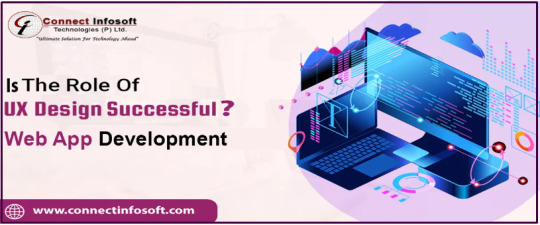
Web applications have become an essential component of our daily lives in today's digital world. From e-commerce platforms to productivity tools and social media networks, web apps are transforming the way we interact, work, and connect with others. However, the success of a web app goes beyond its functionality and features. User experience (UX) design plays a crucial role in ensuring the success of web app development in the USA. In this blog, we will explore the key aspects of UX design and its impact on successful web app development in the USA.
What is UX Design?
UX design focuses on creating meaningful and enjoyable experiences for users who interact with a web app. It includes several components such as usability, accessibility, visual design, information architecture, and interaction design. The goal of UX design is to understand user needs, behaviors, and motivations to design intuitive interfaces that provide a seamless and satisfying user experience.
Why is UX Design Important for Web App Development?
1. User-Centric Approach:
UX design puts users at the center of the development process. By conducting user research, usability testing, and gathering feedback, designers gain insights into user needs, pain points, and preferences. This user-centric approach ensures that the web app meets the expectations of its target audience, leading to higher user satisfaction and engagement.
2. Improved Usability:
Usability is a critical aspect of UX design. A web app that is easy to navigate, intuitive to use, and provides clear feedback enhances user satisfaction and efficiency. UX designers in the UK focus on creating clean and organized interfaces, optimizing information architecture, and designing logical user flows. This attention to usability improves the overall user experience and reduces user frustration, leading to higher adoption rates and user retention.
3. Visual Appeal:
While functionality is important, aesthetics also play a significant role in UX design. The visual design of a web app influences how users perceive and interact with it. In the USA, UX designers pay attention to creating visually appealing interfaces that align with the brand identity, use appropriate color schemes, typography, and imagery. A visually attractive web app can captivate users, improve engagement, and leave a lasting positive impression.
4. Accessibility and Inclusivity:
Inclusivity is a key consideration in web app development. UX designers in the USA ensure that web apps are accessible to users with disabilities and meet accessibility guidelines. This involves designing interfaces that are compatible with screen readers, providing alternative text for images, using color contrasts that are accessible to visually impaired users, and considering other accessibility requirements. By prioritizing accessibility, web apps can reach a wider audience and provide equal access to information and services.
5. Streamlined User Flows:
UX design focuses on creating smooth and intuitive user flows within a web app. This involves mapping out user journeys, identifying pain points, and designing interfaces that guide users towards their desired goals. By streamlining user flows, UX designers in the USA ensure that users can easily navigate through the app, complete tasks efficiently, and achieve their objectives with minimal effort. This improves user satisfaction and encourages users to return to the web app.
6. Iterative Design Process:
UX design follows an iterative process that involves continuously gathering user feedback, testing, and refining the design. This approach allows designers to identify and address usability issues, improve the user interface, and incorporate user preferences throughout the development process. By embracing an iterative design process, web app development in the USA can deliver products that are fine-tuned to meet user expectations and provide an exceptional user experience.
7. Competitive Advantage:
In a crowded digital marketplace, a superior user experience can give a web app a competitive edge. By prioritizing UX design, businesses in the USA can differentiate themselves from competitors, attract more users, and build customer loyalty. A web app that offers a delightful and intuitive experience not only encourages users to engage with the app but also generates positive word-of-mouth recommendations, leading to increased user acquisition and market share.
Conclusion:
UX design plays a crucial role in successful web app development in the USA. By adopting a user-centric approach, improving usability, focusing on visual appeal, ensuring accessibility and inclusivity, streamlining user flows, following an iterative design process, and gaining a competitive advantage, businesses can create web apps that deliver exceptional user experiences. Investing in UX design is not only essential for meeting user expectations but also for driving user adoption, engagement, and long-term success in the dynamic digital landscape of the USA.
Tags: Web App Development in USA, Web App Development, UX Design in USA, Looking for Web Development, Looking for Web Development Services, Looking for Web Developer, E-commerce Web Developer, Looking for Web Designer
#ui ux company#ux desgin#ui ux design#ui ux development services#user interface#web developer#web development#webdesign#web design#website#uidesign#ui design
1 note
·
View note
Text

It's my 1 year anniversary on Tumblr 🥳
0 notes
Text
#digital marketing service company#digital marketing company#digital marketing#saas development company#webdesign#web design#website#web development#web developer
1 note
·
View note
Text
Flutter app development
"Connect Infosoft offers cutting-edge Flutter app development services, harnessing the power of Google's versatile UI toolkit to create stunning, cross-platform applications. Our team of experienced developers crafts seamless, responsive apps tailored to meet your specific business needs, ensuring optimal performance and user satisfaction. With Connect Infosoft, unlock the potential of Flutter to reach a wider audience across multiple devices, all while maintaining a consistent and visually appealing user experience."
#flutter web dev#flutter development company#flutter developers#flutter development#flutter developer
1 note
·
View note
Text
1 note
·
View note
Text
How to Prepare For An Upcoming Website Redesign Project - EuropeWebsiteDesigner
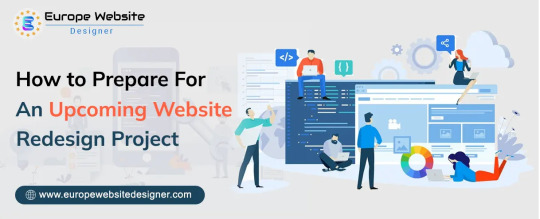
A well-designed and user-friendly website is crucial for the success of any business or organization. As technology and design trends evolve, it becomes necessary to periodically update and redesign websites to stay relevant and provide a seamless user experience. However, a website redesign project can be a complex and daunting task if not properly planned and executed.
We will guide you through the essential steps to prepare for an upcoming website redesign project, ensuring a smooth and successful process.
Step 1: Define Your Goals and Objectives
Before diving into a website redesign project, it’s essential to have a clear understanding of your goals and objectives. Take the time to evaluate your current website and identify its strengths and weaknesses. Discuss with your team what you want to achieve with the redesign. Are you aiming for a more modern look, improved functionality, better search engine optimization, or enhanced user experience? Clearly defining your goals will help you stay focused throughout the project.
Step 2: Conduct a Comprehensive Website Audit
Performing a thorough website audit will provide valuable insights into the performance and usability of your current website. Analyze your site’s traffic, user behavior, conversion rates, and engagement metrics. Identify the pages that are performing well and those that need improvement. Additionally, conduct a content audit to evaluate the relevance and effectiveness of your existing content. This audit will serve as a foundation for making informed decisions during the redesign process.
Step 3: Understand Your Target Audience
To create a website that resonates with your target audience, it is essential to understand their needs, preferences, and behaviors. Conduct user research, surveys, and interviews to gain insights into their expectations. Analyze the demographics, purchase patterns, and browsing habits of your target audience. This information will help you tailor the redesign to meet their specific requirements and deliver a seamless user experience.
Step 4: Develop a Structured Information Architecture
A well-organized and intuitive information architecture is critical for a successful website redesign. Start by creating a sitemap that outlines the structure and hierarchy of your new website. Consider user flow and navigation, ensuring that visitors can easily find the information they need. Develop a logical content structure, grouping related topics and pages together. This step will provide a solid foundation for the design and development stages.
Step 5: Collaborate with Web Designers and Developers
Engage a skilled team of web designers and developers who can bring your vision to life. Collaborate closely with them throughout the project to ensure the website aligns with your goals and objectives. Share your findings from the website audit, user research, and information architecture to provide them with valuable insights. Regular communication and feedback loops will help maintain transparency and achieve the desired outcomes.
Step 6: Plan Content Strategy and Migration
Content plays a vital role in engaging and informing your website visitors. As part of the redesign process, create a content strategy that aligns with your goals and objectives. Determine what content needs to be updated, rewritten, or removed. Develop a plan for content migration, ensuring that important information is seamlessly transferred to the new website. Take this opportunity to optimize your content for search engines and improve its readability.
Step 7: Implement Responsive Design and Mobile Optimization
In today’s mobile-driven world, responsive design and mobile optimization are no longer optional—they are essential. Ensure that your new website is responsive and adapts seamlessly to different devices and screen sizes. Test your website on various devices and browsers to ensure a consistent user experience across platforms. Mobile optimization will not only improve user satisfaction but also positively impact your search engine rankings.
Step 8: Test, Launch, and Monitor
Before launching your redesigned website, thorough testing is crucial to identify and fix any bugs or issues. Conduct extensive quality assurance testing across various browsers, devices, and screen resolutions. Test all forms, interactive elements, and functionalities to ensure they are working as intended. Once satisfied with the testing phase, launch your new website and closely monitor its performance. Keep an eye on key metrics such as traffic, bounce rates, conversions, and user feedback to track its success.
Conclusion:
Preparing for a website redesign project is a vital step to ensure its success. By defining your goals, conducting a comprehensive audit, understanding your target audience, developing a structured information architecture, collaborating with professionals, planning content strategy and migration, implementing responsive design, and conducting thorough testing, you will set the stage for a seamless and successful website redesign. Remember, a well-designed website that meets the needs and expectations of your target audience can significantly enhance your online presence and drive your business forward.
#web design#web developer#web development#flutter developer#connect infosoft#mobile app development service#websitedevelopment#connect infosoft technologies#flutter web dev#flutter dev team
1 note
·
View note
Text
What Does It Mean to Be a Computer Vision Engineer? Unlocking the power of sight in machines

In today's digital age, computers have become increasingly adept at processing and understanding visual information. This remarkable progress is primarily due to the field of computer vision, a subfield of artificial intelligence (AI) that focuses on enabling machines to extract meaningful insights from images or video footage. At the heart of this revolution lies the computer vision engineer, a skilled professional responsible for designing, developing, and implementing the algorithms and systems that empower machines to see and interpret the visual world.
We will explore the role of a computer vision engineer and delve into the fascinating world of computer vision.
Understanding Computer Vision:
Computer vision is the interdisciplinary field that combines computer science, mathematics, and AI to enable machines to acquire, process, analyze, and interpret visual data. It aims to replicate human vision capabilities by endowing machines with the ability to perceive and understand the content of images or videos. By harnessing computer vision techniques, machines can detect objects, recognize patterns, perform facial recognition, track movements, and even interpret emotions.
The Role of a Computer Vision Engineer:
A computer vision engineer is an expert who specializes in developing algorithms, designing models, and creating systems that enable machines to "see" and comprehend images or video data. These professionals possess a profound understanding of computer vision theory, image processing techniques, and machine learning algorithms. Their primary responsibilities include:
1. Research and Development:
Computer vision engineers stay at the forefront of the latest research and advancements in the field. They explore new algorithms, investigate cutting-edge techniques, and experiment with novel approaches to solve complex visual problems.
2. Algorithm Development:
They design and develop algorithms that allow machines to extract relevant information from visual data. This involves tasks such as image segmentation, object detection, image classification, and image recognition.
3. Data Preprocessing:
Computer vision engineers preprocess and clean large volumes of visual data, ensuring it is suitable for analysis and training machine learning models. They may employ techniques such as filtering, normalization, and augmentation to enhance the quality and diversity of the data.
4. Machine Learning:
These engineers leverage machine learning algorithms, such as convolutional neural networks (CNNs) and recurrent neural networks (RNNs), to train models that can recognize and interpret visual patterns and features. They fine-tune these models through iterations of training, validation, and testing.
5. Model Deployment:
Once the models are trained and optimized, computer vision engineers deploy them into production systems or integrate them into larger software frameworks. They ensure the models are efficient, scalable, and capable of handling real-time or near-real-time visual processing tasks.
Applications of Computer Vision:
The applications of computer vision are vast and diverse, with numerous industries benefit from this technology. Some notable applications include:
1. Autonomous Vehicles:
Computer vision plays a critical role in enabling self-driving cars to perceive their surroundings, detect obstacles, and make informed decisions based on the visual data received from cameras and sensors.
2. Healthcare:
Computer vision assists in medical imaging analysis, aiding in the diagnosis of diseases, identification of anomalies in scans, and the development of personalized treatment plans.
3. Surveillance and Security:
Computer vision algorithms can be employed in surveillance systems to detect and track objects or individuals, ensuring public safety and security.
4. Retail and E-commerce:
Computer vision enables automated visual product recognition, facilitating inventory management, visual search, and augmented reality (AR) applications.
5. Robotics:
Computer vision helps robots perceive their environment and manipulate objects with precision. It enables them to grasp, navigate, and interact with the world around them.
Skills and Qualifications:
Becoming a computer vision engineer requires a combination of technical expertise and a strong foundation in computer science and mathematics. Some essential skills and qualifications include:
1. Proficiency in Programming:
Strong programming skills, particularly in languages such as Python, C++, or MATLAB, are crucial for developing computer vision algorithms and implementing them efficiently.
2. Knowledge of Machine Learning:
Familiarity with machine learning concepts, frameworks (such as TensorFlow or PyTorch), and deep learning architectures is essential for training and deploying computer vision models.
3. Image Processing and Computer Vision Libraries:
Experience with popular libraries like OpenCV, scikit-image, or MATLAB's Image Processing Toolbox is beneficial for performing image preprocessing, feature extraction, and analysis.
4. Mathematics and Statistics:
A solid understanding of linear algebra, calculus, probability, and statistics is necessary for designing and optimizing computer vision algorithms.
5. Problem-Solving and Analytical Thinking:
Computer vision engineers should possess strong problem-solving skills and the ability to think analytically to tackle complex visual challenges effectively.
Conclusion:
Computer vision engineers are at the forefront of a technological revolution that empowers machines to see and interpret visual information. Through their expertise in computer science, mathematics, and AI, these professionals develop algorithms, train models, and create systems that enable machines to understand images and videos like humans. With their skills, computer vision engineers drive progress in numerous fields, from healthcare to autonomous vehicles, revolutionizing industries and transforming the way we interact with technology. As the field of computer vision continues to evolve, the role of computer vision engineers will become increasingly vital in shaping the future of AI and visual intelligence.
#computer vision#computer vision engineers#Vertex AI Vision#Vision API#Vision AI Software#Vision AI Development#ision AI Solution#Data Analytics Company#Looking For Machine Learning Dev Team
1 note
·
View note
Text
#etl#etl testing#etl tools#connect infosoft#flutter web dev#web design#web developer#flutter developer#flutter dev team#mobile app development service#connect infosoft technologies#web development#websitedevelopment
1 note
·
View note
Text
How to Create a Winning Web Design Proposal? EuropeWebsiteDesigner

In the competitive world of web design, a well-crafted proposal can make all the difference in securing clients and winning projects. A winning web design proposal not only showcases your skills and expertise but also demonstrates your understanding of the client’s needs and objectives. In this comprehensive guide, we’ll walk you through the step-by-step process of creating a compelling web design proposal that stands out from the competition and increases your chances of success.
Step-by-step process of creating a compelling web design proposal:
1. Research and Discovery:
Before diving into the proposal writing process, conduct thorough research and discovery about the client and their business. Understand their industry, target audience, competitors, and goals. This information will serve as the foundation for crafting a tailored proposal that addresses their specific needs.
2. Executive Summary:
Start your proposal with an executive summary that succinctly captures the client’s requirements, project objectives, and the unique value you bring to the table. Clearly articulate how your design expertise aligns with their business goals, setting the stage for a compelling proposal.
3. Project Scope and Deliverables:
Outline the scope of the project, detailing the specific deliverables you will provide. Clearly define the website’s structure, key features, design elements, and functionalities. Be specific about the number of pages, user flows, and any additional services such as content creation or SEO optimization.
4. Design Approach and Methodology:
Describe your design approach and methodology to give the client confidence in your process. Explain how you will conduct user research, create wireframes, design mockups, and iterate based on feedback. Emphasize the importance of user experience (UX) and responsive design to ensure a seamless and engaging website.
5. Timeline and Milestones:
Provide a detailed timeline outlining the project’s key milestones, including the duration for each phase of the design process. This demonstrates your ability to manage the project efficiently and deliver results within the client’s timeframe.
6. Pricing and Payment Terms:
Present a clear and transparent pricing structure for your web design services. Break down the costs based on the project scope and deliverables. Consider offering different packages or options to cater to different budget levels. Additionally, outline your payment terms, including the deposit amount, milestones, and final payment.
7. Portfolio and Case Studies:
Include a section showcasing your previous work and relevant case studies. Highlight successful projects that align with the client’s industry or objectives. Use visuals and client testimonials to demonstrate the impact of your designs and the satisfaction of past clients.
8. Team and Expertise:
Introduce your team members and highlight their expertise and experience. Emphasize their skills in web design, UX/UI, coding, and project management. This instills confidence in the client that they will be working with a capable and knowledgeable team.
9. Communication and Collaboration:
Outline your communication and collaboration process to ensure transparency and effective project management. Specify the tools and platforms you will use to facilitate communication, document sharing, and feedback collection. Emphasize your commitment to regular updates and open lines of communication.
10. Terms and Conditions:
Include a section outlining the terms and conditions of the project, including ownership rights, confidentiality, revision limits, and termination clauses. This protects both parties and establishes clear expectations for the working relationship.
11. Call to Action:
End your proposal with a strong call to action, urging the client to take the next step. Provide your contact information and encourage them to reach out for further discussion or to move forward with the project.
Conclusion:
Crafting a winning web design proposal requires a thoughtful and strategic approach. By conducting thorough research, clearly outlining the project scope, demonstrating your expertise, and presenting a well-structured and professional proposal, you can differentiate yourself from the competition and increase your chances of securing valuable web design projects. Remember to tailor each proposal to the specific needs and goals of the client, showcasing how your design solutions can effectively meet their requirements. With a winning web design proposal, you’ll pave the way for successful collaborations and long-term client relationships.
Tags: Looking For UI Designer In India, Looking For UX Designer In India, Looking For AI Designer In India, Looking For Designing Team In India, UI UX AI Dev Team, Hire Web Designers In India, Looking For Web Development Company, Cross Platform Apps, Web Designing Company, Connect Infosoft Technologies
#ui ux company#ux desgin#ui ux design#uidesign#connect infosoft#mobile app development service#flutter developer#web design#connect infosoft technologies#web developer#web development#websitedevelopment#ui#ux#user interface#design
1 note
·
View note